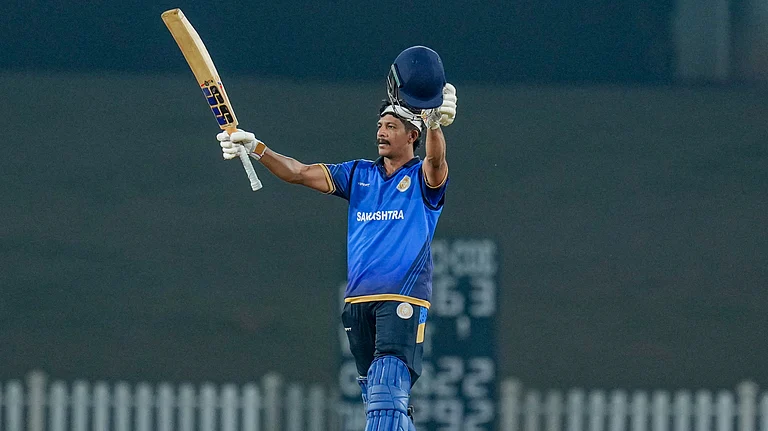When the nation is celebrating 75 years of Indian independence and the effort is to highlight the roles of Indian scientists in the freedom struggle, we must take this opportunity to look back at the collective efforts made by the legends of that time. The popular phrase of the freedom struggle led by Mahatma Gandhi, Pandit Nehru, Maulana Azad, Vallabhbhai Patel and hundreds of others were based essentially on the principle of Ahimsa (non-violence) an active force of the highest order, in the words of Gandhiji. This form of freedom struggle was unique in the world as it was based on people’s resistance like the Non-Cooperation and Civil Disobedience Movements and choice of issues like the Salt Satyagrah, and other events, and not adopting the mode of escape or exile. Building pressure on the British via this slow, but firm, method of "No use of arm and ammunition" and in the words of Gandhiji using the “soul-force on the power of Godhead within us” was tactfully done broadly for the following three reasons:
1. Any such violent activity could be easily suppressed by the mighty British forces.
2. To prepare and train Indian masses to secure Independence with dignity and without loss of blood, so that people having grievances with the state even after independence will resort to persuasion and mass struggle, rather than becoming impatient and resorting to violence.
3. In the meantime such modus kept throwing up leaders to inculcate mindset among the Indian masses to work and bring themselves at par with the developed countries.
During this popular phase of the freedom struggle, the dreamer of progressive India, Nehru played an instrumental and decisive role in convincing the field of experts in different areas to provide inputs to plan a self-reliant, socialistic and cohesive, equitable society. To Nehru, science and technology had to be employed for the agrarian and industrial development of India. Nehru had a firm conviction that “the future belongs to science and those who make friends with science.” A person, who, on one hand, took the help of a film star like Dilip Kumar (Yusuf Khan), in the words of Lord Meghnad Desai “Nehru’s Hero”, to make films to convince people the much needed Socio-Economic Revolution. This can be ascertained by the fact that 36 of Kumar’s 57 films were made during 1947-1964 when Nehru was India’s Prime Minister. Dilip Kumar developed a range of highly popular characters that reflected the idealism and optimism of that period. He played characters that inspired Indian youth, and the idea was that the stardom of Dilip Kumar would result in imitating these characters in the people of young independent India. Besides, Raj Kapoor and scripts were written by the Left-leaning people like Khwaja Ahmad Abbas, a Nehru fan, supplemented the project of nation-building through cinema. The socialistic patterns in the economy and pluralistic tolerance in social relations were paramount concerns articulated through cinema as well. [These points are brought out well by Akbar S Ahmad’s (1992) and Shyam Benegal’s essays (2006)].
Likewise, Nehru had scientific heroes such as Homi Jahangir Bhabha, Vikram Sarabhai, C. V. Raman, Jagdish Chandra Bose, Jnan Chandra Ghosh, Meghnad Saha, S. S. Bhatnagar, P C Mahalanobis, Satyendra Nath Bose, K S Krishnan and many others to make ‘modern temples’ of independent India. Ali Sardar Jafri, a great Urdu critic, poet and film lyricist has once said on Nehru “Three great cultural traditions found harmony in his life: the essence of the ancient Indian civilization, sometimes called Hindu culture; the refined Mughal way of life; and the modern European scientific temper”.
Nehru was a student of natural science at Cambridge during 1907-10, graduated with honours. He then studied law at the Inner Temple Inn, London. He came back to India in 1912 and joined the Allahabad High Court as an advocate. While he was in England his father Motilal Nehru, a lawyer of great repute, was already playing a significant role in the Indian National Congress. Nehru had developed a profound interest in Indian politics during his stay in Britain. Nehru’s foresight and farsightedness are best described in his message to the silver jubilee session (1938) of the Indian Science Congress:
“Though I have long been a slave driven in a chariot of Indian politics, with little leisure for other thoughts, my mind has often wandered to the days when as a student I haunted the laboratories of that home of science, Cambridge, though circumstances made me part my company with science, my thoughts turned to it with longing. In later years, through devious processes, I arrived again at science, when I realized that science was not only a pleasant diversion and abstraction but was of the very texture of life, without which our modern world would vanish away.”
David Arnold writes:
“Nehru was not a practising scientist, nor (despite his undergraduate education at Cambridge) did he possess scientific training. And yet he was one of the principal architects of modern India and, through his enduring commitment to science, a leading figure in the formation of India’s science policy and practice.”
Similar view is also echoed by Baldev Singh (the first Defence Minister of Independent India),
“Independence gave Nehru the opportunity to translate into action his already formed conviction that science was crucial to the solution of India’s needs and problems. In 1937, at his instance, the Congress Working Committee had called on the Congress governments to appoint committees of experts to devise machinery for planning. As Chairman of the National Planning Committee (1938), he had interacted with scientists like Meghnad Saha, P.C. Mahalanobis and others.”
The architect of modern India, Nehru (1889-1964) went to jail at least nine times, spent about a decade in prison and the life in prison gave him time to read and write marvellous books, such as The Glimpses of World History, The Discovery of India [during his incarceration in 1942-45 at the Ahmednagar Fort; which also acknowledges Karl Darrow’s The Renaissance of Physics (1936)], An Autobiography (also known as Toward Freedom) and the letters to Indira.
In the words of George Bernard Shaw “if he had his way, he would always keep Nehru in jail because some of his best writings were penned [from] behind the bars”. Once out of prison, his speeches helped galvanise the youth. Such a mesmerizing personality he was that his speeches directly connected to the audience and exhorted people to develop a scientific temper and deep empathy for the poor and marginalised. His vision and inspiring words gave people a sense of grandness and confidence that India can achieve anything.
Nehru at the National Academy of Science in 1938 spoke about the definite responsibility of scientists and political leadership.
"We have vast problems to face and to solve. They will not be solved by the politicians alone, for they may not have the vision or the expert knowledge; they will not be solved by scientists alone, for they will not have the power to do so or the larger outlook which takes everything into its ken. They can and will be solved by the cooperation of the two for a well-defined and definite social objective."
Throughout the 1920s and 1930s, he roamed among the peasantry and working classes, articulated the Faizpur Agrarian Programme (1936), to push the agrarian relations and landholding pattern towards minimizing the inequalities.
To him, “Knowledge was the product of empirical investigation and logical reasoning, usually known as the scientific method, and any other process led to error. The philosopher, historian, jurist, or literary critic had to be as scientific as the sociologist, economist, or linguist; and, unlikely as it might seem, they had to be no less so than the mathematician, astronomer, and zoologist.”
Gandhiji in 1931 at the second round table conference, exclusively pointed out the ineffectiveness of primary education under British rule and how the policies were responsible for the painful situation in India. The Congress was of the firm view that education should be made free and compulsory to all, to have an all-round development of person’s body, mind and spirit. The British did not pay heed to the repeated appeal of the Congress. Consequently, in a conference by the Indian leaders led by Gandhiji, during 22nd and 23rd October, 1937, in Wardha, passed the following resolution:
- Free and compulsory education to be provided for seven years nationwide (this was the Congress demand since 1905, when Gokhale had presided over the session).
- The mother tongue should be the medium of instruction.
- Throughout this period of seven years, education should be around some forms of manual and productive work, and for this purpose, a handicraft must be chosen, based upon the environment of the child.
- This system would generate remuneration for the teachers.
A committee under the chairmanship of Dr. Zakir Hussain was appointed to formulate the scheme of basic education. The committee submitted its report in 1938 in the form of “Basic National Education” which has a Foreword by Mahatma Gandhi:
“The fact that the first one thousand copies of this pamphlet have been sold out shows that what Dr. Zakir Husain and his committee have called Basic National Education is exciting fair interest in India and outside. A more correct though much less attractive description would be Rural National Education through village handicrafts. ‘Rural’ excludes the so-called higher or English education. 'National’ at-present connotes truth and non-violence. And ‘ through village handicrafts’ means that the framers of the scheme expect the teachers to educate village children in their villages so as to draw out all their faculties through some selected village handicrafts in an atmosphere free from superimposed restrictions and interference.”
Dr. Zakir Hussain starts the report by stating:
“Indian opinion is practically unanimous in condemning the existing system of education in the country. In the past it has failed to meet the most urgent and pressing needs of national life and to organise and direct its forces and tendencies into proper channels. To-day, when quick and far-reaching changes are reshaping both national and international life and making new demands on the citizens it continues to function listlessly and apart from the real currents of life, unable to adapt itself to the changed circumstances. It is neither responsive to the realistic elements of the present situation, nor inspired by any life-giving and creative ideal.”
This report is very exhaustive in almost 200 pages, well crafted and it defines the aims and objectives of each discipline keeping the Indian values and strengths in mind. The outline of the seven year’s course of basic education has: (i) The Basic Craft: spinning and weaving, carpentry, agriculture and others, (ii) Mother Tounge: It emphasizes that the proper teaching of the mother tongue is the foundation of all education (iii) Mathematics (iv) Social Studies (v) General Science: Nature Study, Botany, Zoology, Physiology, Hygiene Chemistry and others (vi) Drawing, and (vii) Music.
If we look at the recent “National Education Policy 2020” released by the Govt.of India, one would find many facets of Dr. Zakir Hussain’s report. Therefore, it is important to understand that our leaders at that time were well aware of our strengths and weaknesses. They were making themselves ready to make India self-reliant immediately after Independence.
This can be reflected by the introduction of the Five-Year Plans. Nehru derived help from Britain, Germany and the erstwhile USSR built several steel plants which laid the foundation for India’s industrial infrastructure. With Maulana Abul Kalam Azad and himself in the driving seat, Nehru set up the Indian Institutes of Technology in Kharagpur, Bombay, Kanpur and Madras. Several hundreds of schools, colleges, the Indian Institutes of Management, All India Institute of Medical Sciences, National Museum, Sahitya Akademi, Lalit Kala Akademi, University Grants Commission, Department of Atomic Energy, Indian National Committee for Space Research and other institutions were also set up. The birth of the Indian space programme had much to do with the closeness between Nehru, Sarabhai and Bhabha and Nehru’s belief in science and accomplished scientists.
While inaugurating the first IIT at Kharagpur in 1951, Maulana Azad said, “One of the first decisions I took on assuming charge was that we must so improve the facilities for higher technical education in the country, that we could ourselves meet most of our needs.” In the first convocation address of IIT Kharagpur, Pandit Nehru said, “Here in the place of that Hijli Detention Camp stands the fine monument of India, representing India's urges, India's future in the making. This picture seems to me symbolical of the changes that are coming to India.”. The Hijli detention camp was an alternative jail, erected in 1930.
Let us go back in history and start with the beginning of the 20th century, an era well before the entry of Mahatma Gandhi. Quite early, our nationalist leadership realised that a self-reliant economy and independent foreign policy needs science, scientific temperament, rationalism, universalism, anti-superstition, etc. Darbhanga Maharaj Lakshmishwar Singh, himself a Congress associate, in 1897, spoke in the Imperial Legislative Council, Calcutta, and provided a fund of Rs 7000 to the Calcutta University to undertake research on finding medicine or vaccine for the epidemic. Inferring from here, do we see in 2020, any big business house coming out to offer such endowment for this purpose, except the offer made by the pharmaceutical firm, CIPLA (of Khwaja Yusuf Hamied; founded in 1935 by his father, a Gandhian, Khwaja Abdul Hamied, a Gandhian), which is well known for producing low cost medicines? In 1904, an Association for the Advancement of Scientific and Industrial Education of Indians was formed. The objective was to send qualified students to America, Europe and Japan for studying science, and after training, when they will come back, will strengthen science and technology in the country so that our country’s industry will grow.
Similarly in early 20th-century Bombay, an alliance of activist doctors, civic leaders and philanthropists, which had support from the Bombay Government and the Bombay Municipal Corporation, established organisations to promote sanitary consciousness, and to tackle the growing incidence of tuberculosis and the high rates of maternal and infant mortality.
Mridula Ramanna focusses on three of them: “the Bombay Sanitary Association (1904), whose objective was disseminating knowledge about diseases, and measures to prevent them; the Anti-Tuberculosis League (1912), which ran an information bureau and dispensary, conducted pathological examinations and medical inspections in mills and schools; and the Lady Willingdon Scheme, (1914) which provided maternal and infant welfare.”
Another giant step was made by the great visionary Sir Asutosh Mukherjee, the then Vice-Chancellor of the University of Calcutta, by opening an independent college, The University College of Science and Technology, in 1914. This college had no financial support from the British Government. It came into existence only because of the generous donation from Sir Taraknath Palit and Sir Rashbehari Ghosh who together donated nearly thirty seven and half lakhs of rupees. Eminent scientists such as Prafulla Chandra Ray, C. V. Raman, S. N. Bose and K. S. Krishnan taught there. Though this college starved financially, but the determination of teachers, as well as students, produced a group of physicists and chemists who received international recognition. Among the several faculty members, Prafulla Chandra Ray had an outstanding contribution and is regarded as the father of chemical science in India. He was not only an eminent chemist but also an industrialist, philanthropist, and staunch nationalist who had observed the deterioration of the Indian society due to suppression by the British colonial rule. He was sympathetic towards the revolutionaries and would make arrangements for their shelter and food at his factories. After his death, many revolutionaries and his colleagues mentioned about his indirect support and help in manufacturing explosives. The Government records mentioned him as a “Revolutionary in the garb of a Scientist”.
Another notable fellow was Jagadish Chandra Bose, the great Indian scientist, who made the world aware that “plants too have feelings”, who did Natural Science Tripos from the University of Cambridge and then D.Sc. from London University. He joined the Presidency College, Kolkata as a professor of Physics. He came to know that he would be offered less salary compared to his British counterparts. He refused to accept the salary and protested against this racial injustice, though he continued to perform his duties and set the example of Satyagrah well before the Gandhiji’s Satyagrah. Later, the British heeded his demand, partially.
It was really difficult to work during the colonial era as they left no stone unturned in undermining the work of Indian scientists. But the scientists surmounted the colonial impediments. Indian scientists have played a significant role in the Indian freedom movement by not only contributing through their meticulous works in science and technology but also helping our great leaders and visionaries to make India self-sustainable. Nehru played the role of a catalyst despite being directly not intrusive into the scientific laboratories.
It would be apt to conclude this with the address to the nation by the then President, Dr. S Radhakrishnan on 27 May 1964, when India’s first Prime Minister passed away:
“Jawaharlal Nehru was one of the greatest figures of our generation, an outstanding statesman whose service to the cause of human freedom are unforgettable. As a fighter for freedom, he was illustrious, as a maker of modern India his services were unparalleled. His life and work have had a profound influence on our mental makeup, social structure and intellectual development. It will be difficult to reconcile ourselves to the image of India without Nehru’s active and all-pervasive leadership.”
(This is part of a mini-talk delivered at the Department of Physics, AMU as a part of the Celebrations of Azadi Ka Amrit Mahotsav, on December 27, 2021).





















